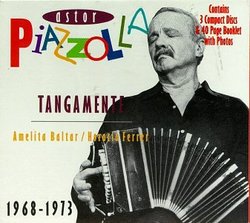A Maverick's Masterpieces
Kurt Harding | Boerne TX | 04/20/2000
(5 out of 5 stars)
"In the late 1960's, Astor Piazzolla consolidated and confirmed his reputation as a maverick, an iconoclast, and a world-class talent. He began to experiment on a new level: with opera, with a freer-form jazz tango, and with vocals. Tangamente is a compilation of some of the best of that period's efforts. The collaboration of Piazzolla and Horacio Ferrer brings a new dimension to the tango. "Contramilonga a la Funerala" is a splendid example of this. No longer is Piazzolla's tango for dancing (if it ever was), it is for listening to every note and nuance. Singer Amelita Baltar's strong, throaty voice is perfect for the interpretations of the Piazzolla-Ferrer collaborations. These songs express the hopes of the Argentine people, their weary resignation and sometimes not-so-veiled dissatisfaction with the Establishment. This is vividly expressed in "Las Ciudades" and "La Primera Palabra". "Balada Para Mi Muerte" is sung with typical porteno melancholy. Baltar is such an expressive singer, its a pity she doesn't have a larger body of work. The four stages of "Pulsacion" go from soft jazz to a hard-driving, explicitly sexual, pulsating jazz and then back into mellowness. These are different from anything Piazzolla had done to this date. I could go on and on. There many very fine works on this set but the greatest of all is the epic "Soledad". It is at once majestic and triumphant yet with an ineffable air of melancholy about it. Its the kind of song you would want played at your funeral, leaving mourners awestruck with its beauty and the feeling that maybe you went to a better place after all. The power of "Soledad" and its sister "Final" will leave you breathless. Buy Tangamente and you will be pleased for life."
A few remarks
Kurt Harding | 07/31/1999
(5 out of 5 stars)
"A truly great box with historical as well as musical value. I'd just like to make a few remarks to the other review here displayed: Piazzolla mentor in the 50's, when he went to Paris, was NADIA Boulanger; and kilombo does not mean whorehouse, it's an african word used to describe the fortified villages formed by black slaves that fled from their masters in colonial times in South America, it was a place of resistance where they fought attempts to be reduced again to servitude. Actually the original pre-Piazzolla tango was the musical style that received the influence of Buenos Aires waterfront life and its numerous bordellos."


 Track Listings (15) - Disc #1
Track Listings (15) - Disc #1